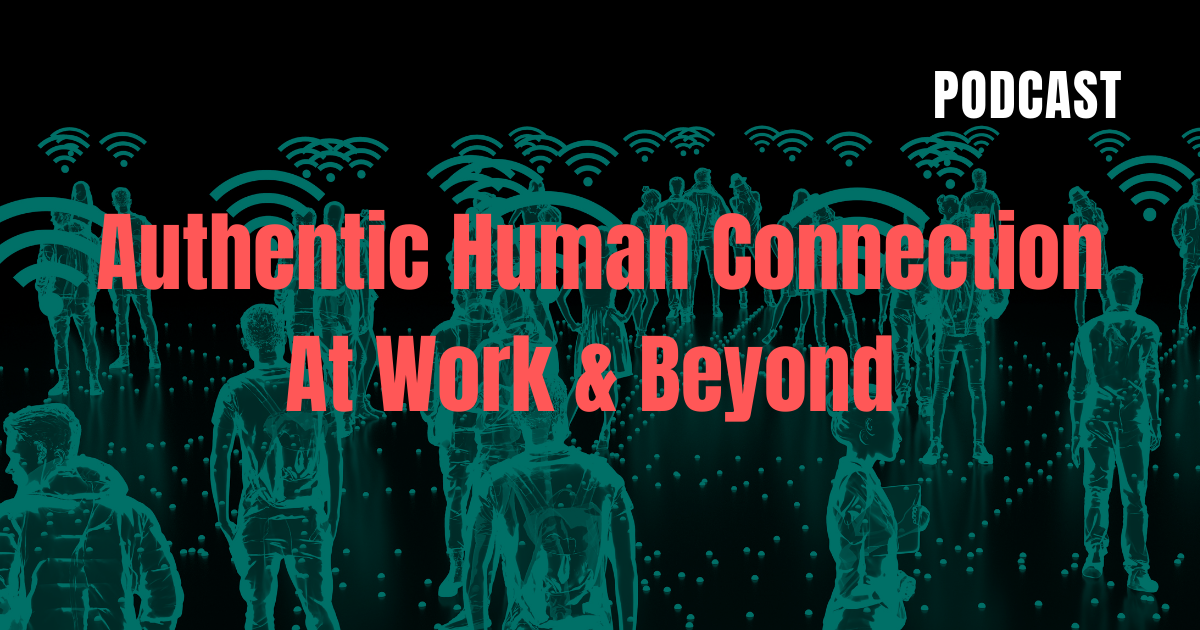“Authentic Human Connection At Work & Beyond” Brief Summary of Show:
In this episode learn to take inspired action as we ask the questions, “How do we have authentic human connection at work & beyond during the current pandemic? And what will human connection look like in future workplaces, whether working from home or in a physical space?” Hosts Kyle and Christopher discuss the future of human connection, and the future of workplaces.
Calls to Action:
Tell us your “inspired stories” stories by visiting www.InspiredActionPodcast.ca
Christopher Lawrence LinkedIn: https://www.linkedin.com/in/career-life-coach-christopher-lawrence/
Kyle Kalloo LinkedIn: https://www.linkedin.com/in/kyle-kalloo/
Change My Life Coaching & Strategic Leader LinkedIn: https://www.linkedin.com/company/6446498/admin/
Change My Life Coaching: https://changemylifecoaching.ca
Strategic Leader: https://strategicleader.ca
“Authentic Human Connection At Work & Beyond” Transcript:
That’s probably the worst
I agree
thing you could do is to treat everyone the same, who should be treated differently.
Is the thought of being imperfect, keeping you from taking action? Welcome to Inspired Action for Imperfect Humans. Each week, we give you real life stories and thought-provoking research, that inspires your soul to live a more fulfilled life, through your own actions. From the heart of Calgary, Canada, here are your hosts, award winning coaches, Christopher Lawrence and Kyle Kalloo.
Well, hello, hello, and welcome back, ladies and gemen, boys and girls, including Christopher James Lawrence. Hello, welcome to another great podcast. You know why I said that, let me tell you why I said that. Look, because I saw your face, I saw your face when I said that you’re like, okay, hello, ladies and gentlemen, boys, and girls. And then me, like, what, am I, am I Let me just tell you why I said that. And I cannot believe I am saying this. I cannot believe, and it’s being recorded.
Yes, careful.
So please know I’m mindful of all of that.
Careful. However, I feel, I still need to say it, I missed you.
What?

I missed you. There, like when, with everything, when we’re working from home and all the stuff, and you know, we were doing our thing, we’re still meeting with clients, we’re still working on the business, we’re doing, but I actually miss our connection. I missed, you know, the constant interruptions or the “Hey, a quick thing” that I’m like, I have my mind set already on something else, and you’re introducing a new problem for me now that I’m going to have to pull my mind away from that thinking to this thing. But I actually miss all that. Why, why did I miss all that?
Me… Me too.
I’m sorry, I didn’t hear you. Could you say that again, sorry?
Oh, sorry, I got…
I did hear your mic, I just want you to repeat it.
I know, I’m just not paying, I’m just not paying attention because we’re talking about sensitive stuff and I do enough of that in the day. So I’m just not listening anymore. You know what, I missed you too. I still feel like I miss you even though we get to see each other in person masked up once in a while, depending on what our local laws are doing.
Right true, true that. I have to go through the backyard. And see you on the porch.
I know, yeah.
In the back.
I have a better chance of seeing you there than, you know, than anywhere else; I miss everybody. I miss meeting random people on the street and smiling.
Or even chatting, even at the grocery story
I know.
because you know, I always, okay, here’s the thing, I always make fun in just that light-hearted way to Christopher about the “how do you do” I always say to him, cause I would be waiting on something where I see him
I love the “how do you do”

and I see him in the corner. And what I mean by that is he would be in the corner, or somewhere in a store, or wherever we go, or on the street, or at the light, it doesn’t matter where it is. As long as there’s another person involved, he’s chatting away and I’m already down the street, I’m already walking away, I’m already up another side of a store, and I’m looking back. I’m like, where is he? Like, he was just behind me. And then I go around and I start looking and there he is, talking to someone and the running joke is I say to him “really like, what did you say?” And usually it’s because he says, “how do you do,” like, he’s asking someone “how are you?, hi.” Like, and that’s all he has to say. And then they spill their guts to him. Next thing you know, he’s like, “Oh yeah, did you know that this was happening, this was going on at work?” And when they started in school, this is what they did throughout their life. And they had 30 years of doing this. I’m like, how the hell did you get all that from “How do you do?” And so that’s why I always say you love how-do-you-do moment.
I just like getting to know people and hearing their stories, and, and so I just ask though, like, like…
But you don’t even ask them to their story, you literally just like, you say “hi”.
I do, I do a little bit, I’ll be just, you know like, you know maybe paying a bill at a restaurant or something, it’s like, “Hey, how’s it going? How’s your day going?” You know? And then, and then I don’t know. I just get these like moments where I want to ask a question like, “do you like it here?” Or “what do you like best about working here?” Or, you know, “where’d you get that T-shirt?” Like, I just ask questions and then girl, before you know it, it’s like, I find out that they’re taking a major at the U of C, and finance, and that they’re not actually sure that that’s what they wanna do. And you know, they grew up in Saskatchewan and went to Walter Murray High School and you know, three and a half minutes later, I come back and I’m like, well, they’re a nice person.
Yeah, you know…
You know what it is?
and I, and I give you that, I gave you that because you, what you do in those moments is you’re really connecting to that authentic human connection. Cause that’s really what it is. Cause if people weren’t, if…
I was just gonna say that.
If they don’t feel connected authentically to you, they’re not going to give you that information. No matter how many surveys, how many things people are asking you, we have our standard line, right. When someone’s like, “hi, how are you? I’m fine. Thank you. How are you?” It’s just, we don’t even have to think about it, right? But when they go beyond that is when we know there’s authentic connect.
I get it from my mum. Cause my mum was like this, like she just walks down the street and she says “hi” to every person. And she’s got one of those smiles. Like she gets along with everybody. If people don’t get along with my mum, it’s usually because they’ve done something or maybe there’s an element of being threatened or something because of who she is. But she gets along with everybody. You look at her DiSC profile and it’s like, she’s an ID, but she actually, she has shading into the S and the C. It’s so rare, like she literally has shading on both sides. It’s like, there’s very little of that circle that she doesn’t actually touch; it’s phenomenal.

And so, because you mentioned DiSC that for our listeners and our people watching, DiSC, if you have never done it, and it’s D-I-S-C for those who may wanna do some research, and it’s small I, right. We’re big fans of the real DiSC, which is a small I. And those people who use the other DISC version
There’s other versions
don’t come for me, don’t come for me, I’m just talking about this.
This one comes from Wiley. And Wiley still… like they’re just continually putting research into it. So they, because as societies change, so do social research,
Of course
so they do change. It doesn’t mean
It gets further…
it’s a perfect tool. There are holes that you can poke in it, but all socially-based tools, you can poke holes in; none of them are perfect.
And just thinking of this tool, what Christopher just mentioned about his mom is at, you know, we usually have a minimum of about three priorities, right? And these are drivers for all of us, and we all have it. I mean, there’s like eight different ones, but there’s three that’s primarily, usually, what it is for us. However, based on what you just said, when you talked about shading there, it just means that she also shares priorities with other style. Although she has a particular style, she also values those things, and see, that’s the thing, we all have priorities we’re trying to fulfill. And sometimes that rub people the other way, you know, sometimes it rubs in the wrong way or may not be as conducive to you. And I think I’m curious about, as we’re talking about this human, authentic human connection is, if the path we’re currently on is all virtual, which is why, like I said, I missed you, I miss having you around, I miss, you know, engaging with you, and just chit-chatting, or just right by the water cooler, how can we be, you know, and we don’t have the ability to be more flexible in a work environment, how do we then promote authentic human connections that are so critical in, in an environment where we can be more engaged, where it can be more collaborative, where we can really adapt that culture? How can we really do that? I think that’s what I want to put out there. What do you think?
I’m going to say something about this because I, I have a couple of comments and I’ve got some stats here that I want to cover, but Kyle, the truth is, is that I do not believe under any circumstances, you can have an authentic human connection, in an organization or with friends, that is purely virtual. I’m not saying you can’t experience authenticity. It’s the human connection part of it, where there will always be that longing and yearning to want to connect, always, in person, because it’s not the same. And everyone will have a different varying level of this, but it’s not the same.
Sure.
I think that virtual workplaces are an awesome way to innovate our planet, totally they are. But you will not, without feeling the presence of that person. I don’t know if it’s because of pheromones or body heat, or micro-, you know, micro-movements or whatever. I think that you cannot have a true, full, human, authentic human connection without actually being face-to-face. You cannot cheat oxytocin or, or serotonin.
Serotonin, yeah. And even those people who were in long distance relationship told you that too, like even before the pandemic, before everything that was happening, people who met someone through Pen-Pal, or wherever, and they met, and then they left each other’s countries and they were continuing that, even they have said, it’s not the same, right. So when they finally meet up again, it’s when we go to that next level. And so, what does the research saying about.

This is, I think you’re exactly right. I think also, I mean, if you’ve ever done online dating, you ever fall in love with, like, a profile, and even the converse…, the text conversation, this and that, and then when you actually meet them, even video, and then you actually meet them, even phone, and then you meet them and you’re like, and you see them interact with others, it’s like, oh, that’s who you are, right? So, here’s interesting, I think that this survey that was done actually speaks, this was research done by Wiley, this research actually speaks to exactly this concept that we’re talking about. 16% of workers say they’ll prefer to work in the office. Okay. I thought that I would actually not be in that category, but I prefer working in the office. Maybe it’s different because it’s my own company, but 19% would like to continue to work remotely.
Interesting.
I thought that number would be way higher.
Totally. I think initially everyone wanted to, right? Cause it makes sense, but then
Of course.
the novelty wears off.
But now it’s been a year and a half and the novelty wears off.
And they realize, they realize it’s not that authentic.
We have friendships of convenience in the workplace. Right, it’s like, oh, it’s like, here’s a friend because we’re in the same place. That’s not a bad thing. I have my friends outside of work. Right? And then I have these friendships of convenience. Some of them are authentic, real friendships, and some of them are friendships of convenience because you’re in the same place at the same time and have common things, and when you leave that workplace, some of those, most of those connections are not maintained.
Right.
For most people, Right? So there’s friendships of convenience. So this is interesting. 65% want to split their time between working remotely and working in the office. And,
Interesting.
I think if you look at that, you look at the ones that want to work in the office and you look the ones that want to split their time, that’s 70, 81%, 81% of people want some form of authentic human connection in the workplace.
Yeah.

Meaning face-to-face, actually meeting with people, touching people, doing that. And then 19% only 19, so less than 20%, wanna continue to work remotely, fully remotely. And I think, I think actually, that that’s indicative of a typical bell curve, right? That’s indicative of a typical bell curve. But what this does say is that more people want that human connection than those that don’t. And I bet you, the 19 that want to work remotely, have set up some kind of situation for themselves, where they’re still getting that kind of connection. I think that workplaces need to look at this, Kyle. I think that they need to look at this. They need to look at a combination of both because that whole “if I can’t see you, you’re not working” bullshit
Yeah
needs to go out the door. What do you think, Kyle?
Yeah. I mean, I agree with that. And I think it opens up another story around what if your job can’t give this to you, but you want that? Do I stay, or do I go? Do I love it, or do I leave it?
Yeah, I think there’s so many factors, right? You have to look at the entire picture because it’s not just about that. But if this is a really big lifestyle thing, I think that you need to work on negotiating to see if you can make it work.
Yeah.
And if not, then, yeah. This is like in your top priorities, there will be, there will be plenty of places offering this moving forward.
Yeah. I just think you just have to know that because if some people try to force that, because we see this and working with clients one-to-one where we try to force all the things that we’re trying to desire in our own life, in an organization that is just not equipped to do it, right or wrong, just not willing to do it, not equipped to do it, doesn’t matter. I mean, they can show up how they want to to do that. And I think, you know, just from a previous podcast we were talking about is, you have to be clear with what it is that you want and tell your leaders, tell those other people that, right. Cause if you need an authentic human connection, then what are you doing to set an environment up to make sure that happens, right? To play out.
Totally agree. So what’s the, what’s the invitation here, Kyle like, what are three things that people could consider, do, you know, in this thing of creating authentic human connections at work and beyond?
So if, as I’m speaking to the leaders in the organization, I would say take a poll of your workplace to find out their preferences. Know for sure, right? These are some stats that we’ve shared that Wiley has done with, you know, over thousands of people who are able to be probably similar in situation who kinda voted on, but what is it in your workplace? What does it look like in your environment? Do you know for sure? You may have a sense and I know some leaders may be fearful because they don’t wanna ask these questions without knowing if they can and can’t so they rather not ask the question. So what I’m saying is you should know, like, it doesn’t mean you’re committing to anything. So I would say number one is, take a poll, right? Understand, and you can do this through one-to-one, you can do this through surveys. You could do it, to be honest with you, the best way is one-to-one. Have conversations with people and just say, I’m just actually curious, if you had to choose here, there, or a combination of the two, what would it look like? The second thing I would say is get an accurate picture of what changes, challenges that you’re currently facing. So what’s happening right now in your environment? This could be at your work organization, this could be at home. What changes or challenges that you are experiencing, bring those things up to the forefront. The third thing I would say is create a coaching culture. Ensure that the environment has a coaching culture, where you guys can talk about what’s happening and then also help the employee and the organization come up with strategies to prepare for those things. Cause oftentimes that’s where that fear comes in. You know, Christopher, is when you don’t know, you have a sense of certain things, but you don’t know. And what do we do? We just don’t move to it. Right? We won’t move to it. Is there anything else you’d add to that list?
I think Kyle, again, we’ve talked about this where we’re kind of on this theme right now. I think individuals need to check in with what they really need. I think you have to ask yourself, what do I need? And start communicating from a place of needs, you know, recognizing that not all needs are met all the time. But I do think that there’s some room for innovation here and it’ll be different for everyone. Where companies are gonna go wrong is they’re going to try and standardize it. And they’re going to say, okay, everybody gets this much. And it’s like, but that doesn’t work for everybody and everybody’s roles; some people need to be more in the office, some need to be less in the office. And so actually what they should do is provide guidelines and allow individual leaders to have those discussions with their teams.
Yeah. Sometimes that whole piece around: if I do for you, I have to do for everyone. And that’s such a limiting factor because it, you know, I remember when I was in an organization where they did the scheduling and they had to rotate the shifts, and it was shift work and they had to rotate the shift because they want to make sure you got X amount of nights, X amount of mid-shift, X amount of morning shift. And as soon as that schedule comes out, Christopher, those people who want nights, were getting it from the other people who had the nights, those people who want mornings, were getting. And I’m like, why do you not just schedule the people who want the nights, nights? Why don’t you just schedule the people who wants the morning? Cause they wanna be fair. They want to make sure there was… if the role doesn’t require that type of diversifying, then what’s the point? Because if the role is, we need a body in the role, then it doesn’t matter. Or if someone is not performing a certain level, they want mornings, but they’re not performing a certain level, then have that coaching culture with them, create an environment where you can say, “Hey, if you want to stay on this shift, this is the expectation, these are deliverables.”
I agree with you. I think the phrase “if I have to do it, I for you, I have to do it for everybody” is an excuse.
Absolutely.
It’s an excuse to, that lacks innovation. There’s so much technology out there. Like there’s this a calendar app, I don’t know what it is, but where it’s like, if you and me and five other people are trying to find a time that we can get together, somebody proposes an initial schedule, and then everybody goes in and fills in what they want. And so literally it’s just like, okay, here’s where we match. You know, there’s two spots that we match. Those kinds of innovations, I look at retail work too. And it’s like, well, it’s this and this and this. And it’s like, post the shifts up, put limitations if this person is part-time or full-time and let them choose, let them trade amongst themselves. Uninvolved management and a scheduler. And if shifts aren’t covered, that’s when you go in and start assigning people,
Why is this so complicated?
This is it, and they do this with like retail work too. It’s so not responsive because the schedules only come out, usually one or two weeks in advance. And I’m like, but using this technology, you could have people choose their own stuff for like four months in advance. And then of course your scheduler would have to have, you know, the opportunity to just say, “Hey, we’re going to be overstaffed here. So I’ve got to take one person off. I’ll take this person. Or, you know, like I need an extra person here because nobody took that shift.” You don’t know, you don’t know if somebody wants to work the late, it’s like, just because your bias says, I want the early shifts so I can leave at 3:00 p.m., doesn’t mean that that’s what everybody else wants.
Absolutely.
And allowing people to set their own office hours, same thing. It’s like, yeah, maybe you say, okay, there is a mandatory team meeting at this stage. And that’s your privilege as a leader because leadership does come with privileges. And so it’s like, it’s going to be on this date and time because that’s what works best for me. You have to be there. But outside of that, why can’t, we’ve got one worker right now, Kyle, she’s been working sometimes at nine and 10:00 p.m. after her kid has gone to bed. And it’s like, that’s when she’s at her best. Why not?
And leaders, you have to step into having different performance conversation instead of the appearance of you trying to manage it. It was a previous world. I remember one guy wanted, he was a manager shift and he always wanted to manage a shift, that was early on in the day. But here’s the thing, is because he wanted to do exactly what you just said, he wanted to leave early, but he’s not awake in the morning. He struggled to actually show up on time and do what has to happen. And so the general manager at the time would not schedule him the morning shifts and told him, you know, I we’re trying to rotate it and blah, blah, blah. And he’d got frustrated. And when I actually took over, I just said, the reason why you’re not getting the morning shifts, cause you’re not awake. You’re not delivering, you’re not doing these things. And here’s the challenge: I was the first person who told him that. All other GM’s and senior leaders before me had the same issue with him but no one told him. So don’t you think he thinks now I have the problem. I’m the one who has a problem with him. And so I had to apologize to him and said, I’m sorry that these other people didn’t tell you, but I am telling you, you tell me, you’re hardly awake. You spend more time in the morning in the office. You’re not actually at the frontline supporting your people. Cause you were tired, you go to bed at midnight, but you’re supposed to show up here, you know, six, seven o’clock in the morning. So leaders step, excuse me, step into that, step into that. If it’s a performance issue with an individual, make it about the individual and stop creating processes that you’re trying to hide behind
Broad-sweeping
because you’re being fair. That’s probably the worst thing you could do is to treat everyone the same, who should be treated differently.
I know we focus so much on, like, corporate culture, but I actually think that we should be focusing on team culture. I think team culture is way more beneficial. Let each team determine… you cannot have a consistent corporate culture across the board with 5,000, or 10,000, or 30,000 employees. You cannot. I would allow teams to develop their cultures. And then just to ensure that the deliverables and accountabilities are there. Yeah, totally, totally agree, that we need to do more for authentic human connections. And I think maybe that is the imperfect inspired action this week is that, you know, what can somebody do in workplace, or at home, to create a more authentic human connection?
It’s our goal to build a global community of inspired action takers, and we can only do that with your help. So if you love inspired action, please leave a review on your favorite podcasting app and share us on your socials. You’ve heard from us, now we want to hear from you. Go to inspiredactionpodcast.ca and tell us what is the inspired action you took this week. Next week on Inspired Action for Imperfect Humans,
Using zoom is exhausting. Just because you could see somebody visually doesn’t mean you connect.



